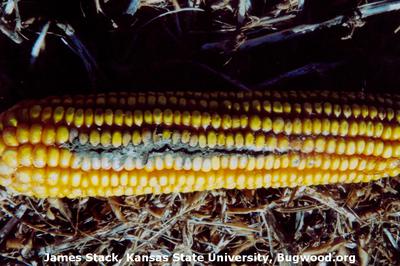Penicillium Ear Rot
Penicillium spp.
Fungus
In a Nutshell
- Affects the corn/maize ears.
- Moldy blue-green growth on cob surface and on kernels.
- Kernels are bleached, rot internally (blue eye).
Can also be found in
Symptoms
Penicillium ear rot is first observed onto the corn kernels after harvest, thereby its name. Plants contaminated during the vegetative stage show stunted growth, wilt and chlorosis. During later plant stages, the fungi can infect the ears, insect lesions or mechanical injuries can serve as entry points. Mechanical injuries can occur during field work or harvest. Elevated temperatures and high humidities lead to the growth of a moldy blue-green growth on the cob surface and on the kernels. The infected kernels are typically bleached and streaked and are also rotting internally (a symptom called blue eye). Sometimes this mold growth is only visible after harvest or during storage. The rotting kernels can lead to yield or post-harvest losses.
Recommendations

Organic Control
Sorry, we don't know of any alternative treatment against Penicillium spp. . Please get in touch with us in case you know of something that might help to fight this disease. Looking forward to hearing from you.

Chemical Control
Always consider an integrated approach before opting for chemical control measures. If really necessary, fungicides containing mancozeb or captan can be applied.
What caused it?
The fungi Penicillium spp. are airborne and ubiquitous in the environment. They are capable of growing at low water availability and survive in infected plant debris in the soil or in storage facilities. They are usually spread through wind and rain splashes and infect ears through wounds. They thrive in high humidities and elevated temperatures. The disease is more common during flower and fruit development. The first symptoms might become visible only during storage.
Preventive Measures
- Use seeds from healthy plant or from certified sources.
- Plant resistant or tolerant varieties.
- Adjust sowing time so that grain filling takes place in times of low rainfall and low humidity.
- Leave sufficient space between plants to allow for good ventilation.
- Keep the field clear of weeds and alternative hosts.
- Take great care not to damage the crops during handling.
- Harvest as soon as possible to avoid damage.
- Maintain seed moisture below 14% during storage to avoid fungal growth on kernels.
- Infected grains should not be used as seeds in subsequent seasons.



